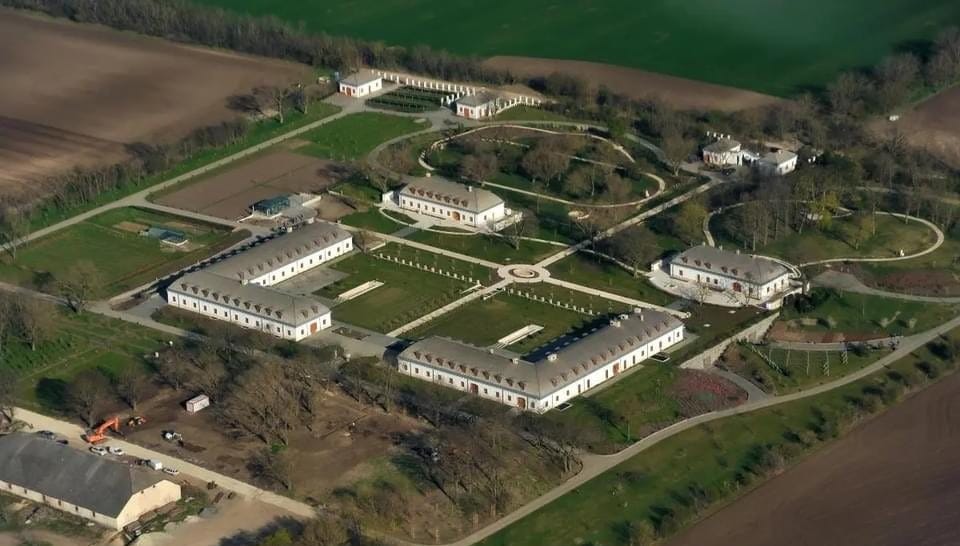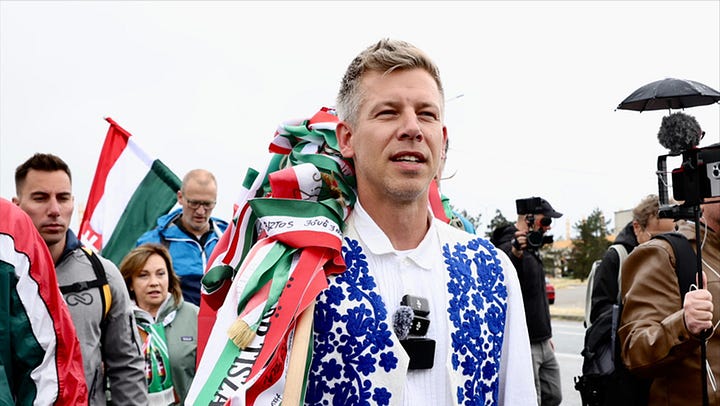This is what a Progressive Leader Looks Like
The left-wing reappropriation of nationalist aesthetics in Hungary
Torchlight rallies. Nationalist symbolism. Ethnic costumes.
If you had to associate these things with a political movement, you probably wouldn’t bet on a progressive, pro-democracy, anti-corruption party working to expand social services. However, in Hungary, the year-and-a-half old TISZA party has enjoyed a meteoric rise by turning the staggeringly corrupt ruling party’s nationalist rhetoric against them. After all, there’s nothing patriotic about using EU funds meant for hospitals to buy yourself a yacht.

It’s no secret that far-right parties are gaining traction across the West. A pattern emerges when we look at how these parties take power. They often appear in societies experiencing a fragmented sense of collective identity, caused in part by sudden migration, or a deepening divide between rural areas and globalized urban centres. Far-right parties harness discontentment with this fragmented sense of identity by providing locals with a coherent and over-glorified national aesthetic. They make sure this nationalist aesthetic is tightly associated with their political party, and use this national-chic to ride a populist wave to power.
The appeal of this sort of party isn’t really policy—it’s aesthetics. Far-right parties can jam almost anything they want into their agendas, so long as they maintain a broadly-appealing nationalist aesthetic that invokes a sense of pride and nationhood.
Almost anything goes once they take power—pocketing public funds, cutting critical social services, centralizing authority, removing anti-corruption safeguards, you name it. As long as far-right parties can melt hearts with patriotic displays and convince people they’ll become foreigners in their homelands if they vote for the opposition, they can stay in power and pocket money for a long, long time.

Eventually, people hit a breaking point.
A couple weeks ago, I was struggling to get a ticket machine to burp out the right train ticket for me to get to Budapest from a nearby town. The train was just about to rumble off without me, so I asked a lady for help; she gave me an extra ticket, and I hopped onboard just in time. She was around 35, a mom, and a manager at a department store. Despite the dilapidated Soviet-era train, she was in a bubbly and talkative mood—she was heading into Budapest on her day off to meet her girlfriends at IKEA.
After we’d run out of small talk, and some medium talk, I broke the silence: “What do you think’s gonna happen with the election this spring?”
“Regime change,” she said. “Let’s hope at least.” She crossed her fingers, and started to cry.
She rummaged through her purse to find a tissue, and we sat silently for a bit. “Sorry. They’ve just really screwed our country over.”
We sat in silence for a bit longer, watching the outskirts of Budapest approach. “Four months ago my best friend passed away from an entirely treatable disease. The hospitals didn’t have the funding to treat her, and she couldn’t afford to go to Vienna for treatment. She was 39.”
So how can an opposition party harness growing anger at a corrupt far-right regime in an era of aestheticized politics?
In the West, the typical response to right-wing nationalism has been to problematize or condemn the aesthetic being harnessed by right-wing leaders to soar to power.
After the Gadsden Flag (once a symbol of resistance to colonial rule) shows up at enough Trump rallies, Democrats refuse to touch it. When the Saint George’s Cross appears in too many rural towns, progressive Londoners avoid it.
National symbols start being associated with ‘those guys’, and eventually feel ‘icky’ when political tensions heat up.
Problematizing national aesthetics as a response to their use by the far-right means fighting an uphill battle.
National aesthetics tend to be very potent, and typically represent everyone in the voting body. If you’re trying to win the vote of the average French citizen, it's easier if you associate your party with the Tricolour and La Marseillaise, than with the Progress Pride flag and the Internationale. All French citizens, practically from birth, are taught to identify with the former set of symbols, while only a subset of French voters will identify with the latter.
Some attempts have been made by progressive groups to invent new aesthetics to compete with the national aesthetics appropriated by the right, but typically, these attempts have fallen flat. Today, the Progress Pride flag is used primarily as a cultural marker, to indicate a devotion to progressive ideals. On university campuses, a sort of islamo-leftist aesthetic has emerged, and is sported by young leftists to represent their political affiliation.
Although these political aesthetics can be effective on a municipal level, they struggle to win voters on the national level. A party that needs to distance itself from imagery shared by diverse groups that span the voting body (or a party that adopts an alternative aesthetic), will struggle to win broad support compared to a party people automatically associate with their country’s tunes and colours.
Is there an alternative for progressives in an era of aestheticized politics? Well—you could adopt the national aesthetic yourself!
This is exactly how Hungary’s progressive TISZA party, headed by the young and charismatic Péter Magyar, managed to overtake the ruling party in the polls in just eight months.


Péter Magyar has been campaigning all across Hungary, stopping in virtually every village to shake hands, and make his party known in rural areas where non-government-controlled media rarely penetrates. Along the way, he wears ethnic costumes, sings folk songs, takes part in local customs, organizes torchlight rallies, waves the flag, and recites nationalist poetry with a full chest.
Hungary’s opposition has become visibly more Hungarian than the ruling party who uses nationalism to barricade itself into parliament while it fleeces the nation.
Despite launching scathing criticisms of the ruling party, Magyar has survived the onslaught of attacks that levelled previous opposition movements. It’s hard to convince people the opposition is a sinister, anti-Hungarian entity controlled by Brussels, scheming to flood the country with migrants, when the opposition leader is wearing folk costumes and talking politics with shepherds.
It’s hard for the far-right to demonize a progressive party when progressives appeal to the same national aesthetics—and maybe even do it better.
Although politics is increasingly driven by aesthetics instead of policy, the political landscape in Hungary proves that far-right nationalist parties can be challenged—not by trying to develop a new aesthetic, but by reappropriating the nationalist-chic of the far-right, which disarms the movement in the process.
Embracing nationalist imagery wouldn’t just be a politically wise move for progressives, but an honest one too.
You can’t claim to love your country while pocketing money meant for hospitals, killing your fellow countrymen. You can’t call yourself a patriot if you systematically dismantle the safeguards meant to preserve your democracy. The left fights for all these things and more, so progressives shouldn’t hesitate to wear the nation’s colours.






